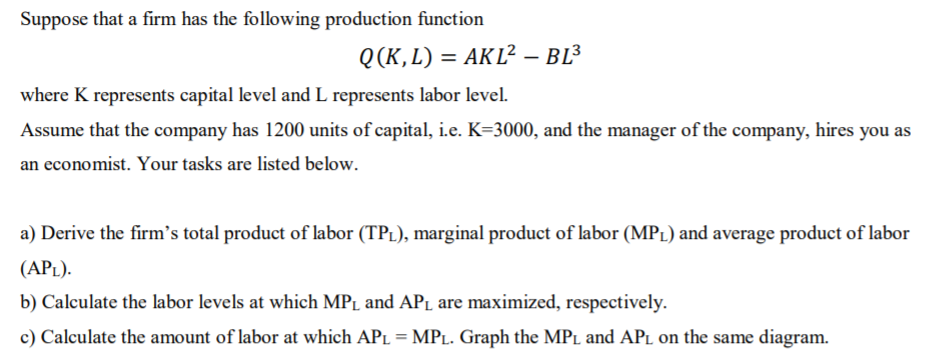Suppose that a firm has the following production function Q(K,L) = AKL² – BL³ where K represents capital level and L represents labor level. Assume that the company has 1200 units of capital, i.e. K=3000, and the manager of the company, hires you as an economist. Your tasks are listed below. a) Derive the firm's total product of labor (TPL), marginal product of labor (MPL) and average product of labor (APL). b) Calculate the labor levels at which MPµ and APı are maximized, respectively. c) Calculate the amount of labor at which APL MPL. Graph the MPL and APL on the same diagram. %3D
Suppose that a firm has the following production function Q(K,L) = AKL² – BL³ where K represents capital level and L represents labor level. Assume that the company has 1200 units of capital, i.e. K=3000, and the manager of the company, hires you as an economist. Your tasks are listed below. a) Derive the firm's total product of labor (TPL), marginal product of labor (MPL) and average product of labor (APL). b) Calculate the labor levels at which MPµ and APı are maximized, respectively. c) Calculate the amount of labor at which APL MPL. Graph the MPL and APL on the same diagram. %3D
Managerial Economics: Applications, Strategies and Tactics (MindTap Course List)
14th Edition
ISBN:9781305506381
Author:James R. McGuigan, R. Charles Moyer, Frederick H.deB. Harris
Publisher:James R. McGuigan, R. Charles Moyer, Frederick H.deB. Harris
Chapter7: Production Economics
Section: Chapter Questions
Problem 7E
Related questions
Question

Transcribed Image Text:Suppose that a firm has the following production function
Q(K,L) = AKL² – BL³
where K represents capital level and L represents labor level.
Assume that the company has 1200 units of capital, i.e. K=3000, and the manager of the company, hires you as
an economist. Your tasks are listed below.
a) Derive the firm's total product of labor (TPL), marginal product of labor (MPL) and average product of labor
(APL).
b) Calculate the labor levels at which MPL and APı are maximized, respectively.
c) Calculate the amount of labor at which APL = MPL. Graph the MPL and APL on the same diagram.
Expert Solution
This question has been solved!
Explore an expertly crafted, step-by-step solution for a thorough understanding of key concepts.
This is a popular solution!
Trending now
This is a popular solution!
Step by step
Solved in 5 steps with 1 images

Knowledge Booster
Learn more about
Need a deep-dive on the concept behind this application? Look no further. Learn more about this topic, economics and related others by exploring similar questions and additional content below.Recommended textbooks for you

Managerial Economics: Applications, Strategies an…
Economics
ISBN:
9781305506381
Author:
James R. McGuigan, R. Charles Moyer, Frederick H.deB. Harris
Publisher:
Cengage Learning



Managerial Economics: Applications, Strategies an…
Economics
ISBN:
9781305506381
Author:
James R. McGuigan, R. Charles Moyer, Frederick H.deB. Harris
Publisher:
Cengage Learning




Microeconomics: Principles & Policy
Economics
ISBN:
9781337794992
Author:
William J. Baumol, Alan S. Blinder, John L. Solow
Publisher:
Cengage Learning

Exploring Economics
Economics
ISBN:
9781544336329
Author:
Robert L. Sexton
Publisher:
SAGE Publications, Inc